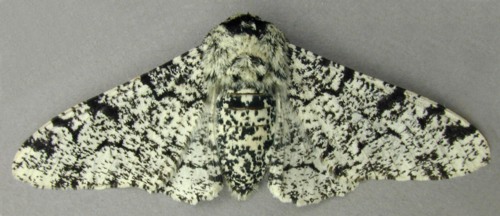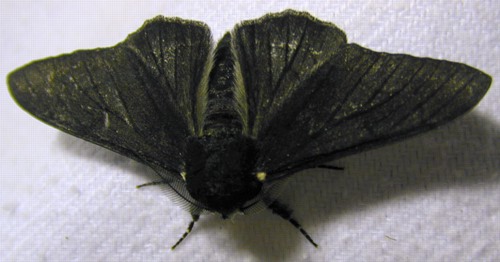
Photo courtesy
http://www.bioimages.org.uk/HTML/P168240.HTM

ASL
The image above is a peppered moth. This is the common form of the moth. Before the industrial revolution in England, most if not all, of the peppered moths looked like this. Near Manchester England in 1848, the first documentation of a dark peppered moth was reported. Were there any dark peppered moths in England in the year of 1847?

Photo courtesy
http://www.bioimages.org.uk/HTML/P160822.HTM

ASL
England's industrial areas, like Manchester, burned large amounts of coal. Burning coal produced air pollution. The soot and sulfur dioxide, SO2, turned the forests and cities dark, almost black. By 1895, the dark moths in Manchester had reached a reported level of 98%. Peppered moths only have one generation each year. In less than 50 generations, the ratio of light to dark had reversed.

ASL
Before the industrial revolution, the tree trunks were light colored. This was because the bark and lichens that grew on the trees were light colored. The air pollution changed the tree color. The SO2 killed the lichens and the soot turned the trunks black. The moths changed color at the same time the trees did.

ASL
In 1896, J. W. Tutt theorized that the ratio had reversed because of bird predation. He reasoned that before the pollution, the light moths were camouflaged on the light lichens. The birds selected the moths to eat that they could see easier. When the trees turned dark, more of the dark moths lived to pass on their dark alleles to their progeny. This is one of the first observed examples of natural selection.

ASL
Tutt didn't do any experiments to support his position. At the end of the 19th century, many scientists felt that observation of nature was the best kind of science. They felt that setting up experiments distorted the situation. They didn't trust these distorted or contrived situations. By the end of the 19th century, there were several different conflicting opinions on how and why species change.

ASL
Scientists spend a lot of time criticizing their research. This constant criticism isn't because scientists think their fellow scientists are doing bad science. The opposite is true. Scientists criticize each other to encourage more questions, experiments and discoveries. Today's science is based on yesterday's discoveries. Scientists share the science. This means they share the responsibility for checking and looking for ways to improve the science.


